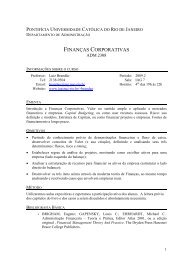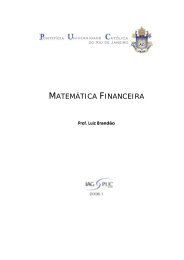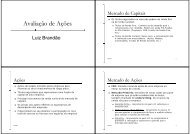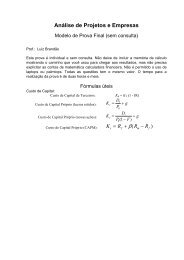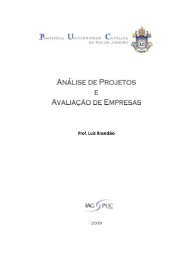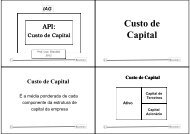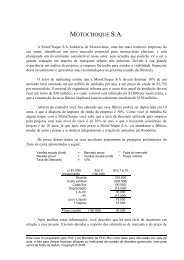Aula 1 - IAG - A Escola de Negócios da PUC-Rio
Aula 1 - IAG - A Escola de Negócios da PUC-Rio
Aula 1 - IAG - A Escola de Negócios da PUC-Rio
You also want an ePaper? Increase the reach of your titles
YUMPU automatically turns print PDFs into web optimized ePapers that Google loves.
ADM 1351<br />
Administração<br />
Financeira<br />
Programa<br />
• Conceitos Básicos<br />
• Avaliação <strong>de</strong> Fluxo <strong>de</strong> Caixa<br />
• Análise Financeira<br />
• Planejamento Financeiro<br />
• Avaliação <strong>de</strong> Obrigações e Títulos<br />
• Decisões <strong>de</strong> Investimento<br />
Prof. Luiz Brandão<br />
2006<br />
2 BRANDÃO<br />
Programa<br />
• Administração do Capital <strong>de</strong> Giro<br />
• Risco e Retorno<br />
• Custo <strong>de</strong> Capital<br />
• Avaliação <strong>de</strong> Empresas<br />
Bookmarks<br />
• ADM 1381:<br />
www.iag.puc-rio/~bran<strong>da</strong>o<br />
• Damo<strong>da</strong>ran: Avaliação <strong>de</strong><br />
Investimentos<br />
http://www.stern.nyu.edu/~a<strong>da</strong>mo<strong>da</strong>r<br />
• Copeland: Valuation<br />
http://mckinseyquarterly.com/home.htm<br />
3 BRANDÃO<br />
4 BRANDÃO
Finanças<br />
Finanças – Evolução<br />
TEMPO<br />
RISCO<br />
Até início do Século XX<br />
• Parte <strong>de</strong> Economia e principalmente <strong>de</strong>dica<strong>da</strong> à manutenção <strong>de</strong><br />
registros contábeis.<br />
CAPITAL<br />
1900<br />
• Finanças emerge como uma disciplina separa<strong>da</strong> <strong>de</strong> Economia.<br />
• Gigantescas consoli<strong>da</strong>ções como a <strong>da</strong> US Steel e Stan<strong>da</strong>rd Oil<br />
(Esso) no início do século.<br />
• Necessi<strong>da</strong><strong>de</strong> <strong>de</strong> emissão <strong>de</strong> <strong>de</strong>bêntures e ações em gran<strong>de</strong><br />
escala e <strong>de</strong> maior conhecimento do funciona-mento do mercado<br />
<strong>de</strong> capitais.<br />
• Bancos <strong>de</strong> investimento.<br />
5 BRANDÃO<br />
6 BRANDÃO<br />
Finanças – Evolução<br />
1920<br />
• Inovação tecnológica e crescimento levam as empresas a<br />
precisarem <strong>de</strong> mais recursos.<br />
• Gran<strong>de</strong> ênfase na liqui<strong>de</strong>z e financiamento <strong>da</strong>s empresas.<br />
• Pouca ênfase na administração interna.<br />
1930<br />
• Depressão nos EUA.<br />
• Finanças se concentra no estudo <strong>da</strong> preservação <strong>da</strong> liqui<strong>de</strong>z,<br />
reorganização e falência <strong>da</strong>s empresas.<br />
• Ênfase ain<strong>da</strong> no ponto <strong>de</strong> vista do investidor externo, sem<br />
abor<strong>da</strong>r aspectos <strong>de</strong>cisórios <strong>da</strong> empresa.<br />
• Maior regulamentação governamental e regras mais rígi<strong>da</strong>s<br />
para o mercado <strong>de</strong> capitais.<br />
7 BRANDÃO<br />
Finanças – Evolução<br />
1940<br />
• Predomina a visão tradicional <strong>de</strong> finanças - o ponto <strong>de</strong> vista<br />
externo.<br />
• Bases para análise pelo fluxo <strong>de</strong> caixa, planejamento e controle<br />
são lança<strong>da</strong>s.<br />
1950<br />
• Fase <strong>de</strong> gran<strong>de</strong> crescimento. Início do estudo <strong>de</strong> como se<br />
processam as <strong>de</strong>cisões na empresa.<br />
• Valor presente, <strong>de</strong>cisões <strong>de</strong> investimento <strong>de</strong> capital, controle,<br />
conceito <strong>de</strong> valor, orçamento.<br />
• Avaliação crítica dos efeitos <strong>da</strong> estrutura <strong>de</strong> capital e <strong>da</strong> política<br />
<strong>de</strong> divi<strong>de</strong>ndos <strong>da</strong> empresa.(MM)<br />
8 BRANDÃO
Finanças – Evolução<br />
1960<br />
• Teoria <strong>de</strong> Carteira (Markowitz, 1952) e sua aplicação em<br />
finanças.<br />
• CAPM (Sharpe) e a teoria do mercado <strong>de</strong> capitais eficientes.<br />
• Início do uso <strong>de</strong> informática em finanças.<br />
1970/80<br />
• CAPM - APT<br />
• Mo<strong>de</strong>lo <strong>de</strong> avaliação <strong>de</strong> <strong>de</strong>rivativos (Black/Scholes)<br />
• Preocupação com inflação e volatili<strong>da</strong><strong>de</strong><br />
• Nascimento <strong>de</strong> <strong>de</strong>rivativos financeiros e softwares <strong>de</strong> quarta<br />
geração.<br />
• Início <strong>da</strong> Globalização dos mercados.<br />
• Gran<strong>de</strong> ativi<strong>da</strong><strong>de</strong> <strong>de</strong> fusões e aquisições ao final <strong>de</strong>sse período<br />
9 BRANDÃO<br />
Finanças – Evolução<br />
1990 -<br />
• Globalização <strong>de</strong> mercados e diversificação internacional para<br />
gestão <strong>de</strong> riscos.<br />
• Avanços em tecnologia <strong>de</strong> telecomunicações, informações e<br />
sistemas.<br />
• Aumento do comercio internacional e <strong>de</strong> investimento direto<br />
transnacional.<br />
• Desregulamentação, privatização e crescimento dos mercados<br />
globais.<br />
• Aumento <strong>da</strong> volatili<strong>da</strong><strong>de</strong> econômica e do risco<br />
• Aumento do uso <strong>de</strong> instrumentos financeiros complexos - novos<br />
<strong>de</strong>rivativos financeiros.<br />
• Utilização <strong>de</strong> programas “peritos” para análise <strong>de</strong> risco e<br />
retorno.<br />
10<br />
• Valor para o acionista.<br />
BRANDÃO<br />
Finanças – Evolução<br />
2000 -<br />
• Estouro <strong>da</strong> bolha <strong>da</strong> Internet e Telecom (2001)<br />
• Aumento <strong>da</strong> volatili<strong>da</strong><strong>de</strong> econômica e do risco<br />
• Avaliação <strong>de</strong> projetos com flexibili<strong>da</strong><strong>de</strong> (Opções Reais)<br />
A Função <strong>da</strong> Administração<br />
Financeira<br />
• Aquisição <strong>de</strong> ativos (Decisão <strong>de</strong> Investimento)<br />
• Financiamento <strong>de</strong> ativos (Decisão <strong>de</strong> Financiamento)<br />
• Administração <strong>de</strong> ativos (Decisão Operacional)<br />
11 BRANDÃO<br />
12 BRANDÃO
Finanças<br />
Decisão <strong>de</strong> Investim. Decisão <strong>de</strong> Financ.<br />
A Função Financeira<br />
na Empresa<br />
Ativo Circulante<br />
Passivo Circulante<br />
Conselho <strong>de</strong> Administracao<br />
Presi<strong>de</strong>nte<br />
Dívi<strong>da</strong>s <strong>de</strong> L.Prazo<br />
Diretor <strong>de</strong> Operacoes<br />
Diretor Financeiro<br />
Diretor <strong>de</strong> Ven<strong>da</strong>s<br />
Ativo Permanente<br />
Capital Acionário:<br />
. Investim. Inicial<br />
. Lucros Retidos<br />
. Novos aportes<br />
Gerente <strong>de</strong><br />
Cré dito<br />
Tesoureiro<br />
Gerente <strong>de</strong> Inv.<br />
<strong>de</strong> Capital<br />
Gerente <strong>de</strong><br />
Planejamento<br />
Contabili<strong>da</strong><strong>de</strong><br />
Gerencial<br />
Controler<br />
Contabili<strong>da</strong><strong>de</strong><br />
Financeira<br />
Planejamento<br />
Tributá iro<br />
13 BRANDÃO<br />
14 BRANDÃO<br />
Funções <strong>da</strong> Administração<br />
Financeira<br />
TESOURARIA<br />
• Administração <strong>de</strong> Caixa<br />
• Crédito e Cobrança<br />
• Relações Bancárias<br />
• Aplicação Financeira<br />
• Investimento <strong>de</strong> Capital<br />
• Obtenção <strong>de</strong> Financiamentos<br />
• Administração <strong>de</strong> Seguros<br />
CONTROLE<br />
• Contabili<strong>da</strong><strong>de</strong> Financeira<br />
• Contabili<strong>da</strong><strong>de</strong> <strong>de</strong> Custos<br />
• Planejamento Fiscal e Tributário<br />
• Aplicação Financeira<br />
• Investimento <strong>de</strong> Capital<br />
• Obtenção <strong>de</strong> Financiamentos<br />
• Administração <strong>de</strong> Seguros<br />
As Maiores<br />
Empresas<br />
15 BRANDÃO<br />
16 BRANDÃO
Maiores Empresas por Receita<br />
(US$ Bilhões/2005)<br />
Empresa<br />
Receita<br />
British Petroleum $345<br />
Exxon 317<br />
Shell 306<br />
Wall-Mart 305<br />
General Motors 193<br />
Ford Motor 178<br />
Daimler Chrysler 176<br />
Chevron 174<br />
Total 168<br />
Toyota 166<br />
General Electric 171<br />
Valor<br />
248<br />
381<br />
241<br />
190<br />
15<br />
16<br />
57<br />
135<br />
171<br />
166<br />
348<br />
17 BRANDÃO<br />
Qual é o objetivo <strong>da</strong><br />
empresa<br />
18 BRANDÃO<br />
Pesquisa Exame<br />
Gerar empregos<br />
Desenvolver o país<br />
Des. trab comunitários<br />
Cresc e justiça social<br />
31%<br />
42%<br />
60%<br />
93%<br />
Objetivo <strong>da</strong> Empresa:<br />
Criação <strong>de</strong> Valor<br />
Pagar impostos<br />
29%<br />
Ser ética<br />
19%<br />
Derrotar a concorrência<br />
10%<br />
Gerar lucro<br />
10%<br />
Pesquisa Exame, 28/03/2005<br />
19 BRANDÃO<br />
20 BRANDÃO
Maiores Empresas Globais em<br />
Valor <strong>de</strong> Mercado<br />
Empresa 2006 Origem<br />
Exxon Mobil $ 381 USA<br />
General Electric 348 USA<br />
Microsoft 295 USA<br />
British Petroleum 248 UK<br />
Shell 241 UK<br />
CitiGroup 237 USA<br />
Pfizer 191 USA<br />
Wal Mart 190 USA<br />
Toyota 168 JPN<br />
Google 128 USA<br />
21 BRANDÃO<br />
Maiores Empresas Brasileiras em<br />
Valor (USD milhões - Fev/06)<br />
Empresa Valor Empresa Valor<br />
Petrobras 94.578 Arcelor 9.669<br />
CVRD 55.538 Ger<strong>da</strong>u 8.686<br />
Bra<strong>de</strong>sco 35.858 Telemar 7.781<br />
Itaubanco 31.055 SID 7.370<br />
Ambev 25.377 Cemig 7.055<br />
Banco do Brasil 19.416 Embraer 6.972<br />
Itausa 12.915 Caemi 6.812<br />
Unibanco 12.593 CPFL 6.662<br />
Eletrobras 10.791 Usiminas 6.564<br />
Telesp 10.536 Gol 5.980<br />
Fonte: Bovespa<br />
22 BRANDÃO<br />
Merck<br />
Impacto do anúncio <strong>da</strong> retira<strong>da</strong> do Vioxx do mercado<br />
Remédios mais Vendidos (2006)<br />
Lipitor colesterol Pfizer $10.3 bilhões<br />
Zocor colesterol Merck $ 6.1<br />
Zyprexa Anti-psicótico Eli Lilly $ 4.8<br />
Norvasc pressão Pfizer $ 4.5<br />
Procrit anemia J&J $ 4.0<br />
Prevacid estomago Take<strong>da</strong> & Abbott $ 4.0<br />
Nexium estomago AstraZeneca $ 3.8<br />
Plavix coração Bristol-Myers Squibb $ 3.7<br />
Advair asma GlaxoSmithKline $ 3.7<br />
Zoloft Anti-<strong>de</strong>pressivo Pfizer $ 3.4<br />
23 BRANDÃO<br />
24 BRANDÃO
Merck<br />
GM: Evolução <strong>da</strong>s Ven<strong>da</strong>s<br />
Impacto do anúncio que a empresa havia perdido a<br />
primeira ação in<strong>de</strong>nizatória <strong>de</strong> $253 milhões.<br />
250.000<br />
200.000<br />
150.000<br />
100.000<br />
50.000<br />
0<br />
95 96 97 98 99 00 01 02 03 04<br />
25 BRANDÃO<br />
26 BRANDÃO<br />
25.000<br />
Cisco Systems: Evolução <strong>da</strong>s Ven<strong>da</strong>s<br />
25%<br />
Cisco e GM: Margens <strong>de</strong> Lucro<br />
20.000<br />
20%<br />
15.000<br />
15%<br />
10.000<br />
10%<br />
5.000<br />
5%<br />
0<br />
93 95 97 99 01 03<br />
0%<br />
-5%<br />
95 96 97 98 99 00 01 02 03 04<br />
27 BRANDÃO<br />
28 BRANDÃO
• Em 1989 o Banco Garantia<br />
comprou o controle acionário <strong>da</strong><br />
Brahma por cerca <strong>de</strong> $60<br />
milhões <strong>de</strong> dólares.<br />
• Esse valor representava 51%<br />
<strong>da</strong>s ações ordinárias <strong>da</strong><br />
empresa (20% do total <strong>de</strong><br />
ações).<br />
• Isso significa que a empresa<br />
to<strong>da</strong> foi avalia<strong>da</strong> em $300<br />
milhões<br />
29 BRANDÃO 30 BRANDÃO<br />
• Os novos sócios mo<strong>de</strong>rnizaram a<br />
empresa, fizeram investimentos e o<br />
negócio cresceu com o aumento <strong>de</strong><br />
consumo com o Plano Real<br />
• Investimento cresceu para $1 bilhão<br />
<strong>de</strong> dólares em 8 anos.<br />
• Com a aquisição <strong>da</strong> Antártica, a<br />
Brahma que já era a quarta maior<br />
cervejaria do mundo, passou a ser a<br />
segun<strong>da</strong> maior como Ambev.<br />
4000<br />
3000<br />
2000<br />
1000<br />
Brahma: Ven<strong>da</strong>s (R$ milhôes)<br />
• Em 2003 passou a fazer parte do<br />
grupo InterBrew.<br />
0<br />
87 89 91 93 95 97 99<br />
31 BRANDÃO<br />
32 BRANDÃO
500<br />
Brahma: Lucro ($milhões)<br />
Lógica De Um Bom Investimento<br />
$100<br />
375<br />
Empresa atrai<br />
investidores<br />
Investidor pensa<br />
nas opções<br />
Decisão <strong>de</strong><br />
investir<br />
Empresa inicia a<br />
execução<br />
250<br />
125<br />
0<br />
87 89 91 93 95 97 99<br />
O recurso se<br />
transforma em<br />
ativo<br />
$120<br />
33 BRANDÃO<br />
O ativo gera<br />
produtos<br />
Os produtos são<br />
vendidos<br />
O <strong>de</strong>sempenho<br />
é avaliado<br />
O recurso<br />
retorna<br />
ADM 1351<br />
Administração<br />
Financeira<br />
Prof. Luiz Brandão<br />
2006<br />
35 BRANDÃO



